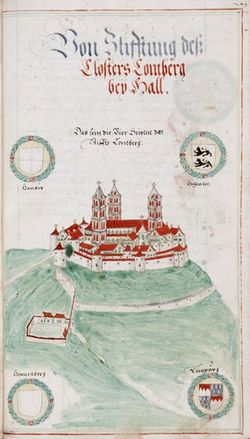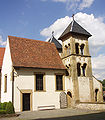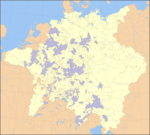- Comburg
-
Imperial Abbey of Comburg
Reichsstift GroßcomburgImperial Abbey of the Holy Roman Empire ← 
1070s–1587  →
→Comburg at the end of the 16th century Capital Comburg Abbey Government Theocracy Historical era Middle Ages - Founded, with immediacy 1070s - Converted to
collegiate foundation
1488- Mediatised to Württemberg 1587 - Secularised 1803 Today part of  Germany
GermanyComburg was a Benedictine monastery near Schwäbisch Hall in Baden-Württemberg in Germany.
It was founded in the late 1070s by the Counts of Comburg-Rothenburg on the site of their castle. They retained the office of Vogt, which continued until their extinction in the Staufer dynasty. The first monks were from Brauweiler Abbey, but in the 1080s an abbot from Hirsau Abbey was appointed, and this brought Comburg into the movement of the Hirsau Reforms.
The monks of Comburg were exclusively of noble birth, and accordingly resisted the Benedictine reforms (the Melk Reforms) of the 15th century, under the pressure of which the monastery became a collegiate foundation (German: Kollegiatstift) in 1488, rather than admit non-nobles to the community.
In 1587 Comburg was mediatised by Württemberg, which brought to an end its status as an Imperial abbey.
The community was secularised in 1803. The library survives in the Württemberg State Library, but the church treasure was melted down in the Ludwigsburg mint.
The buildings have had a number of uses since then. Until 1909 a regiment of invalid soldiers (the Ehreninvalidenkorps) was based here. During World War II the site was used for a variety of training purposes and also at one point as a prisoner of war camp. After the war it was used briefly for housing displaced persons, but since 1947 it has housed a teacher training establishment.
References
(in German)
- Hause, Eberhard, 1981. Die Komburgen: ihre Bauwerke, Baumeister und Bauherren. Weinsberg.
- Jooß, Rainer, 1987. Kloster Komburg im Mittelalter. Studien zur Verfassungs-, Besitz- und Sozialgeschichte einer fränkischen Benediktinerabtei (Forschungen aus Württembergisch Franken; Bd. 4), 2nd ed. Sigmaringen. ISBN 3-7995-7629-0
- Kleiber, Gabriele, 1999. Groß- und Kleincomburg. Berlin: Staatliche Schlösser und Gärten Baden-Württemberg in Zusammenarbeit mit der Staatsanzeiger für Baden-Württemberg GmbH. ISBN 3-422-03061-1
- Schraut, Elisabeth (ed.), 1989. Die Comburg: Vom Mittelalter bis ins 20. Jahrhundert. Ausstellung im Hällisch-Fränkischen Museum und auf der Comburg, Neue Dekanei, 13. Juli bis 5. November 1989 (Catalogue of the Hällisch-Fränkisch Museum, Schwäbisch Hall; Bd. 3), Sigmaringen. ISBN 3-7995-3303-6
External links
- (English) Kloster Großcomburg in Castles and Gardens of Baden-Württemberg
- (German) Adliges Ritterstift St. Nikolaus Komburg in the database of Abbeys in Baden-Württemberg of the State Archives of Baden-Württemberg
- (German) Kapuzinerkloster Kleinkomburg in the database of Abbeys in Baden-Württemberg of the State Archives of Baden-Württemberg
- (German) Archives of Comburg Abbey in the State Archive of Ludwigsburg
 Holy Roman Empire — Imperial abbeys of the Swabian College
Holy Roman Empire — Imperial abbeys of the Swabian CollegeImperial abbeys and colleges
(Reichsabteien, Reichsklöster
und Reichsstifte)Baindt • Comburg • Disentis • Elchingen • Frauenchiemsee • Fraumünster • Fürstenfeld • Gengenbach • Göss • Gutenzell • Heggbach • Helmarshausen • Herrenalb • Irsee • Kaisheim† • Lindau • Lorsch • Marchtal • Marmoutier • Maulbronn • Mönchrot • Mondsee • Murbach* • Neresheim • Ochsenhausen • Ottobeuren • Petershausen • Prüfening • Reichenau • Roggenburg • Rottenmünster • St. Gall's* • St. George's in Isny • Salem • Schänis • Schussenried • Schuttern • Söflingen • Ursberg • Waldsassen • Weingarten • Weissenau • WettenhausenImperial charterhouse
(Reichskartause)- Also a Prince of the Empire † Also in Rhenish College
Categories:- Imperial abbeys
- Former theocracies
- Former countries in Europe
- States of the Holy Roman Empire
- States and territories established in the 1070s
- States and territories disestablished in 1587
- Monasteries in Baden-Württemberg
- Benedictine monasteries in Germany
- 1070s establishments
- 1803 disestablishments
- Christian monasteries established in the 11th century
Wikimedia Foundation. 2010.






